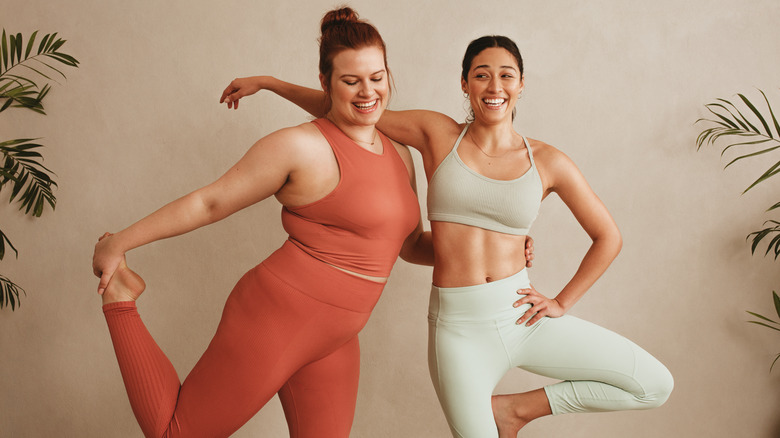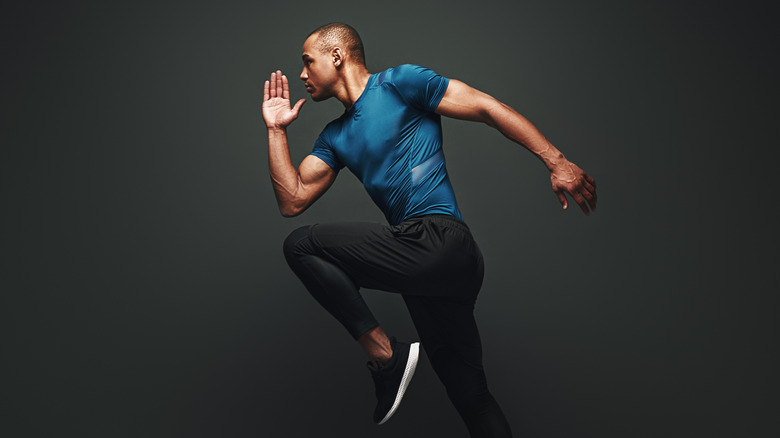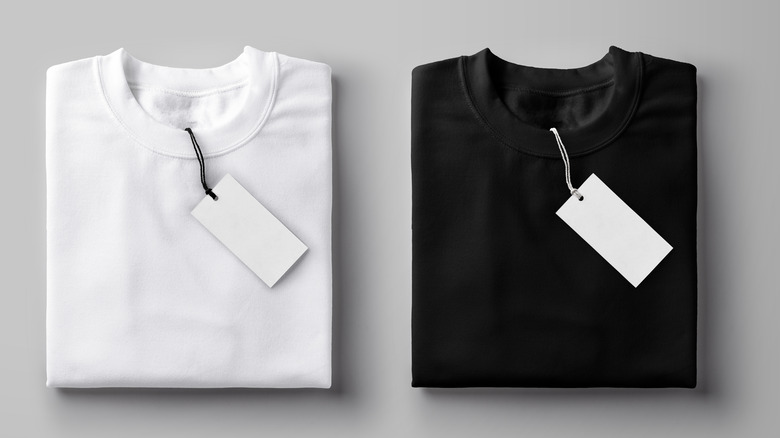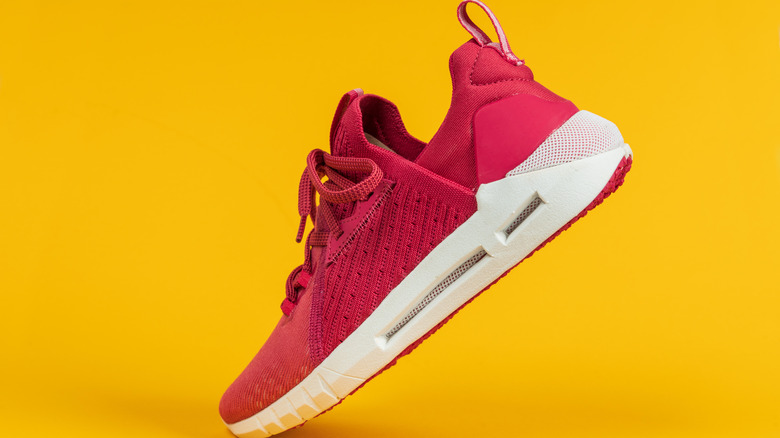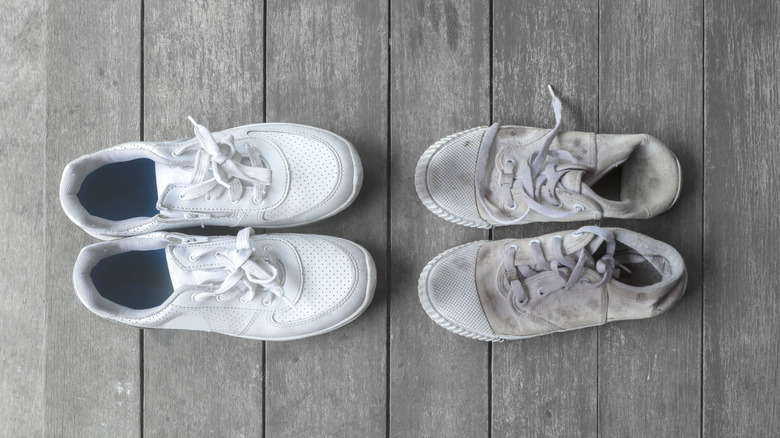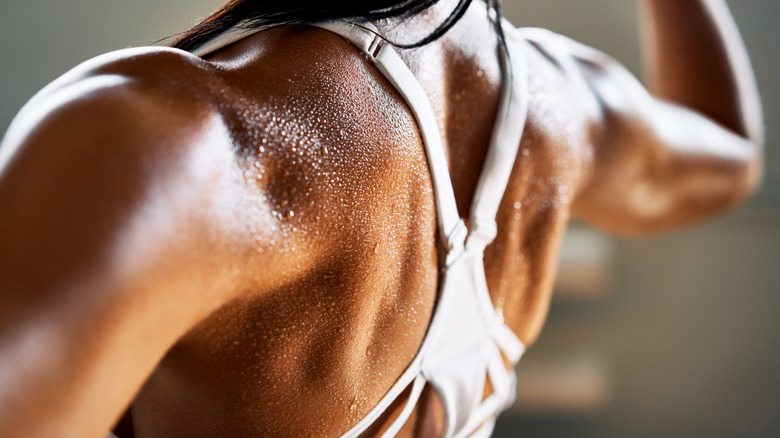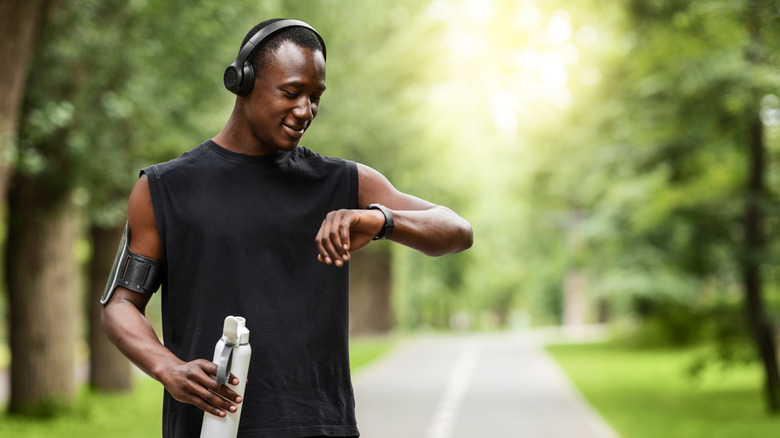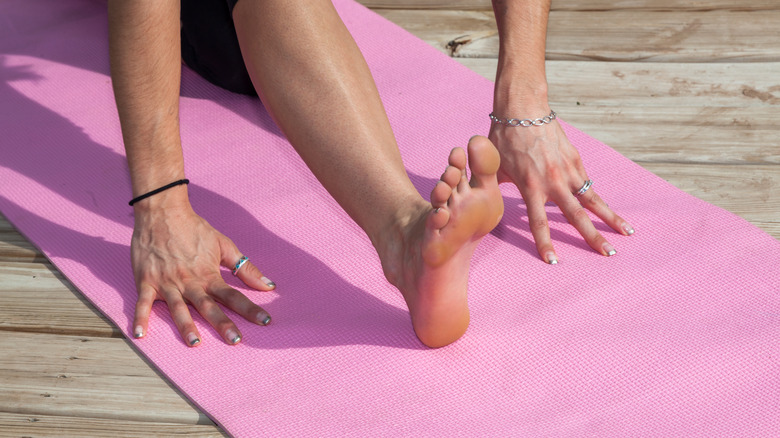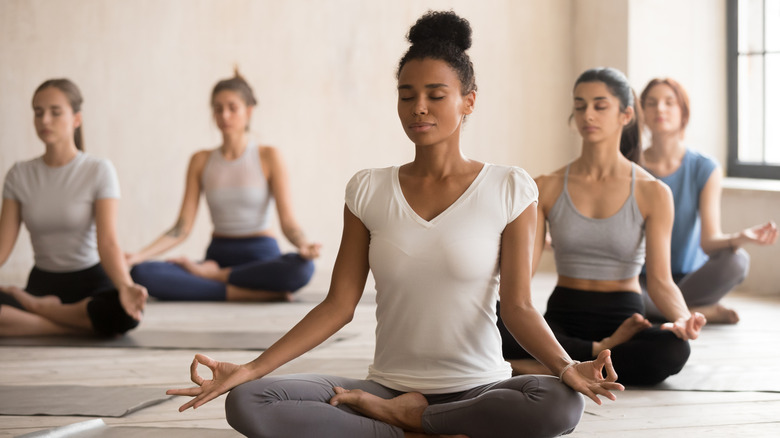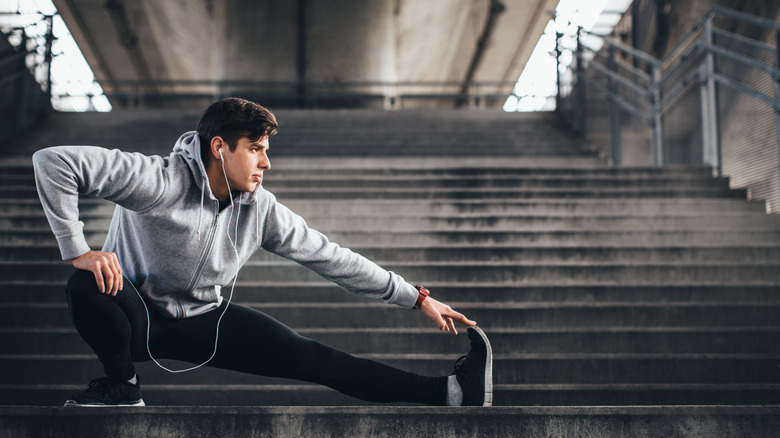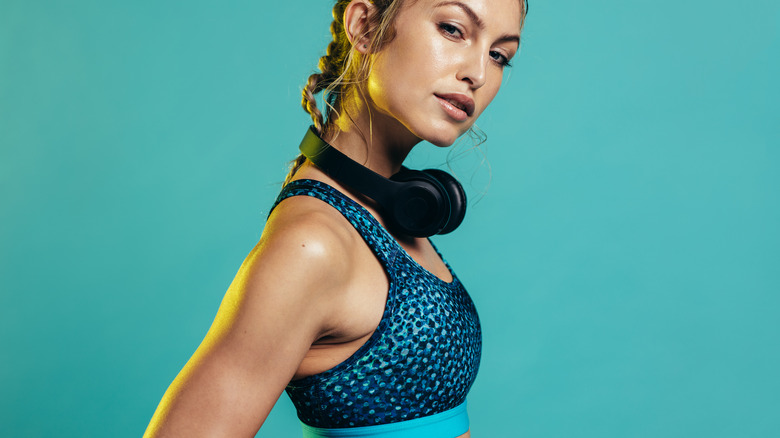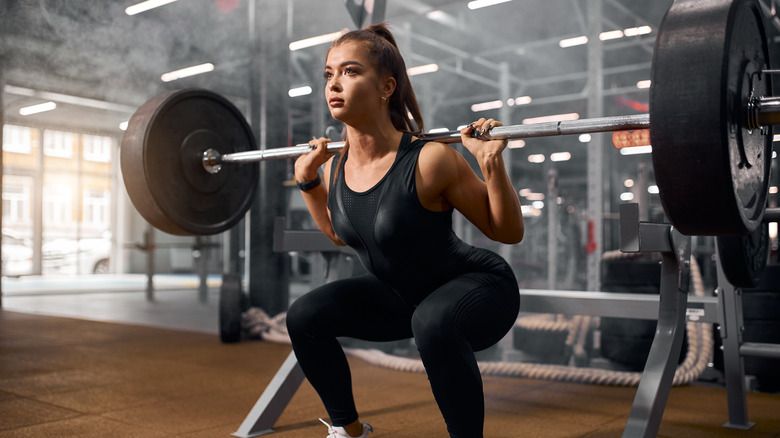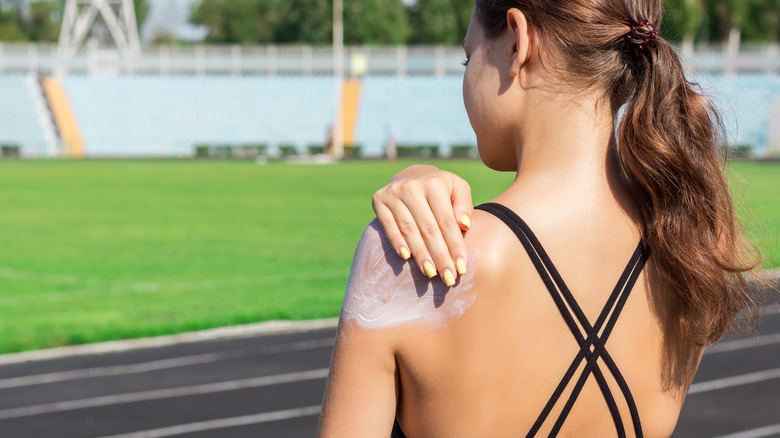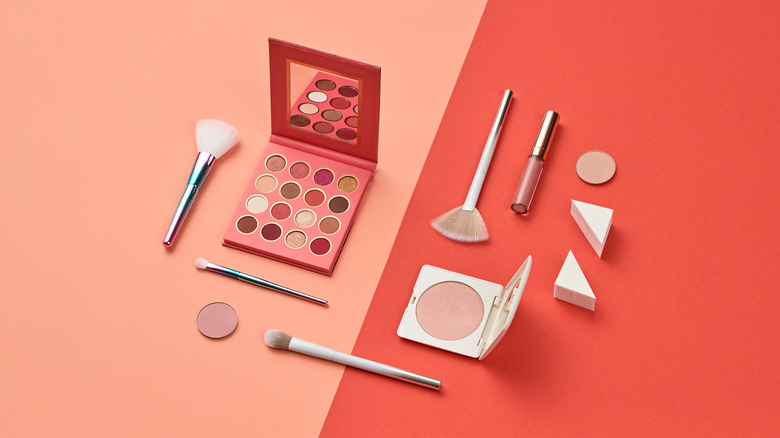7 Best And 7 Worst Things To Wear During Your Workout
Sportswear is big business. And predictably, it's only going to get bigger. According to Market Watch, the size of the global sports apparel market was an eye-watering $263.4 million in 2020, and is due to rise by almost $100 million in value by 2026. And there's good reason for the size of the market, aside from the sheer fact that a lot of these clothes look really cool. Finding the right clothing for your workout is something that sports apparel designers have used to create garment after garment because at the end of the day, finding the right clothing for your workout is super important. "Wearing appropriate clothing is crucial when you are an avid exerciser," stated top human performance expert and creator of HPE Activewear Nick Harris to Harper's Bazaar. "Many sports injuries occur because of the lack of appropriate equipment, including clothes."
But, with the overwhelming amount of things to choose to wear when you're working out, how do you know the right thing to put on — and, perhaps more importantly, what things should you definitely be avoiding? Well, here at Health Digest, we've done the legwork for you.
Best: moisture-wicking fabrics
If you're the type of person who gets a sweat on during a workout, you'll need to make sure that what you're wearing is well-equipped to handle the sudden influx of bodily moisture. That's why clothes made of moisture-wicking fabrics are one of the most practical and comfortable choices you can make when shopping for workout clothes, thanks to their ability to keep you dry and cool. According to Nike, moisture-wicking fabrics work by keeping the sweat on the surface of the clothing, using a capillary-like system to move the sweat to the top layer of the clothes speedily, allowing the sweat to evaporate. This is in contrast to a lot of clothes made with natural fibers, which can allow sweat to seep into the clothing and settle, leaving you damp and uncomfortable.
When you're shopping for a moisture-wicking piece of clothing, look for the material they're made of, as the most effective can often be made of synthetic fibers like nylon and polypropylene. It can pay to shop around to look for clothing made of super-thin fibers, too. As Thomas Jefferson University's associate professor of materials technology Janet Brady pointed out, "The finer the diameter [of the fibers], the more individual fibers you can get in one yarn, which means more tiny channels that sweat can run along."
Worst: 100% cotton clothes
Your favorite, most comfortable day-to-day T-shirt might feel like a natural fit to don before you head to the gym, but if that garment's made of 100% cotton, you're going to want to leave it at home. Clothes made of 100% cotton, despite how soft they can feel, are pretty much the worst thing you can choose to wear when you work out, primarily because of how inefficient they are at dissipating sweat, as the International Sports Science Association (ISSA) explains.
While cotton is efficient at absorbing sweat from your body, it doesn't know how to wick it away from the skin, as a moisture-wicking fabric does. As a result, the sweat stays in the material, rubbing up against your skin and keeping you wet. As a result, this has an impact on how effectively your body keeps itself cool. The ISSA explained that to help your body cool down during exercise, the sweat has to be able to evaporate from your skin. The outcome is a super-sweaty, super-stinky, and super-steamy workout that'll leave you gasping for breath. Take expert advice — stick to the synthetic moisture-wicking fabrics.
Best: well-fitted training shoes
When it comes to planning a killer look, starting at the bottom is a wise way to go — and the same is true of gym wear as it is anything else, and not just for fashion's sake. Getting a well-fitted pair of training shoes is a must for any exercise enthusiast, due to the important role they play in supporting proper physical performance and form, as Hoyles Fitness stated. A proper pair of training shoes work to maintain the correct structure and positioning of your foot during exercise, helping to improve balance and stability, and crucially to avoid injury.
Therefore, it pays to invest in a good pair. For runners, footwear is particularly important, and having a shoe fitted by an expert is an investment in time that pays off, noted WebMD. When you're shopping for shoes, look for a fit that has a little space between your longest toe and the shoe's tip. It should offer enough bend around the ball of your feet, with minimal give around your heel — ideally, there should be no up-and-down movement here — and that makes your foot feel secure and stable. While it's tempting to go for a super-soft, cushioned pair of shoes, make sure you're prioritizing practicality over comfort — ask an informed salesperson if you have any doubts.
Worst: your old sneakers
So you've had your trusty pair of sneakers for a decade, and money's looking a little tight at the moment. Surely it's okay to carry on working out in them, right? Unfortunately, failing to replace your training shoes when they're past their prime can be one of the worst mistakes you make concerning gym clothing, with deterioration in sneakers eventually affecting alignment, explained Ithaca, New York-based physical therapist Jasmine Marcus to Women's Health Magazine. According to Marcus, when the bottoms of exercise shoes start to wear down, their ability to withstand shocks and cushion impact wears down as well, throwing off your foot, knee, and hip alignment.
If you're a runner, common wisdom dictates that you should replace your shoes once you've clocked in 300-400 miles, said Verywell Fit. There are also some telltale wear-and-tear signs to look for, says Marcus, who advised that, "You know your sneakers are too old when the treads or designs on the bottom start to wear out." Additionally, look for flattening in areas in the sole, or any uneven bits that result from wearing down over time. According to Verywell Fit, a good way to tell if your shoes are kaput is by using a "twist test" — if, when twisting the shoe holding it at either end, it feels firm, it should still be fine. If it twists easily (unless it's a particularly lightweight shoe), it could be time for a new pair of kicks.
Best: bamboo
It feels like there's a new-fangled discovery around clothing material every five minutes these days, and so we wouldn't blame you for arching an eyebrow here. But trust us on this one, clothes made with bamboo are a choice that you won't look back from when it comes to workout wear. "Bamboo is the Swiss Army Knife of performance fabrics," stated Tasc Performance designer Sarah Chase to Shape, also noting that in bamboo clothing, "You could run a marathon, then go to spin class, then run errands, and you'll stay fresh, dry, and sun-protected." Sounds pretty good to us (aside from the marathon-to-spin class progression, that is.)
So why is bamboo so good for workout clothing? According to research published in the Journal of Textile and Apparel, Technology and Management, bamboo clothing is naturally moisture-wicking and anti-static, meaning it'll keep you dry, cool, and comfortable throughout a workout. The material is also naturally odor-repellent and sun-protective — and if that wasn't enough, it has a higher level of biodegradability, more efficient use of space, and lower water use than alternatives. Honestly? We're sold.
Worst: clothing with exposed seams
When you're buying workout clothing, it's all too easy to get caught up on what it looks like from the outside — but what's inside, and how it feels, is way more important. Specifically, buying clothing with exposed seams may cause you to rue the day you didn't try on that garment in the store, due to the serious chafing that may occur.
According to Christine Hinton, a running coach who spoke to Podium Runner, this can be an issue when it comes to bras, with exposed seams in sports bras often causing chafing around the bra's bottom band, or as a result of rubbing around the shoulder straps. Hinton advises a workaround for anybody feeling the chafe from their bra. She said, "Some women find relief wearing their bras inside out, so exposed seams are on the outside. A lot of manufacturers are now designing them this way." As well as avoiding exposed seams to stop chafing, it can also pay off to think about the type of fabric you're wearing. As Bustle states, natural fibers like cotton, which retain moisture instead of wicking it away, can result in way more chafing than synthetic fibers like lycra and mesh, specifically designed to keep rubbage at bay.
Best: fitness trackers
Gone are the days of only the most committed runners wearing fitness trackers — today, it seems everybody and their dog has one. And to be honest, there's a pretty good reason for it, with fitness trackers offering a useful way of logging your fitness goals, as well as other benefits for your workout routine. According to a study published in the American Journal of Medicine, individuals who wore fitness trackers tended towards having an increased motivation and inspired vigor to work out.
However, it should be stated that wearing a fitness tracker will not make you healthier in and of itself, and the American Journal of Medicine study did find that wearing one doesn't necessarily result in health benefits. But cardiologist Seth Martin still thinks they're a worthy addition to your workout gear, stating that a fitness tracker "gives people information and empowers them to start making changes for heart health" (per John Hopkins Medicine). Additionally, for people who don't currently use fitness trackers, Martin said, "...often, their activity level was not something they were paying attention to before they started tracking." And this leads to better consciousness around physical health overall.
Worst: jewelry
Most people know that wearing jewelry is far from practical at the gym or yoga studio — but lots of people may notice they forgot to take their earrings or rings off mid-workout. Is it that bad to keep your jewelry on? According to Loma Linda University Health's chair of dermatology Harry Dao, via Shape, the answer to that question could be yes, for several reasons.
The first of these reasons is simply that wearing jewelry during a workout could lead to you having to replace it sooner. Specifically, Dao said, "Softer metals like gold and silver can bend pretty easily as a result of the impact from lifting weights or using gym machines." The annoyance of your favorite ring being bent out of shape aside, though, keeping your jewelry on, particularly gold, can also be pretty hazardous. "Sweat and friction can cause gold to leach out of jewelry," explained Dao, which can then, in some cases, result in allergic contact dermatitis, giving you a nasty rash and other unpleasant symptoms. Jewelry can also easily catch on equipment, advises Dao, which is a huge hazard that can result in serious injury.
Best: well-fitted clothing
If you're not an avid gym-goer (or even if you are), it can be easy to view the clothing apparel market as a little overblown. Do you really need all that well-fitting stuff? Is it not enough to just go in your old T-shirt and sweats? While it's certainly possible to work out in anything, there are definite advantages to wearing properly-fitted, well-made workout clothing that embraces the natural movements of your body when exercising. As human performance expert and HPE Activewear creator Nick Harris stated to Harper's Bazaar, "Lightweight materials and well-designed activewear should feel like a second skin, ensuring you don't feel restricted while you train." By choosing clothing that fits well and that you're at ease in, you're able to focus on your workout without distraction.
Harris also advises that if you're on the hunt for new workout clothes, opting for compression wear could help your body's performance. According to Harris, high-quality compression clothing "increases circulation and blood flow to the heart, delivering much-needed oxygen to working muscles," as well as "reducing fatigue and soreness by managing lactic acid accumulation." These are all things we can get behind.
Worst: clothing that's too tight or too loose
There are few things more irritating in life than clothing that doesn't quite fit properly, and that's rarely more noticeable than when you're trying to focus on reaching a new personal best. But aside from the fact that wearing clothing that's too baggy or too constricting during a workout is just really very annoying, doing so can also have an impact on your body's function and safety. When it comes to tight clothing — although it can feel good — it can cause problems while you're working out, or post workout, said Freeletics training specialist David Wiener to My Imperfect Life. Clothing that's too constricting around your waist or hips, for example, "can lead to pain at the hip joints and also cause spine or circulation issues," Wiener said.
And while loose clothing doesn't have the same potential to restrict, it's problematic in different ways, explained OriGym personal trainer Zac Yeo (via My Imperfect Life). Yeo added, "If you are wearing workout clothes that are too loose, you could potentially trip or fall and injure yourself, or others around you." Loose clothing also has the potential to catch on gym equipment — or generally make you feel bogged down while you're trying to get your workout on.
Best: properly-fitted bra
When it comes to working out, the consensus is that wearing a sports bra is the way to go. But not all sports bras are created equally, and according to the founder of Maaree (a sports bra brand based in the UK) Mari Thomas (via Metro), it's important to find the fit that suits you best, as opposed to just grabbing one off the shelf. "There's no one-bra-suits-all out there," said Thomas, who adds that "what one person may think is good about a sports bra for them, may not be right for you."
The solution, according to Thomas: "Learn about the different types of sports bras out there and get to know what feels and performs well for you." It all starts with figuring out your correct bra size, according to Adidas, by assessing the band and cup fit thoroughly. Once you've done that, it's time to think about what you're going to be using the sports bra with — are you more likely to be doing low-impact exercises like yoga or walking, or high-impact activities like HIIT workouts? This will help you assess whether you need a high-support, medium-support, or low-support bra, all of which have varying ranges of compression, cup design, and strap thickness.
Worst: ill-fitting chest support
Ensuring that your workout clothes fit properly is vital to the success of any workout, and it's important to assess the fit of your chest support too. If the bra you're wearing — even if it's a sports bra — isn't the right fit, then it's no small matter, according to Darria Long Gillespie, the University of Tennessee School of Medicine's clinical assistant professor, who spoke to Women's Health Magazine on the nature of proper chest support during exercise.
As Long Gillespie stated, "bounce isn't the only thing you have to worry about" when it comes to chest support. "If you have a moderate to large chest, the movement can lead to upper back and shoulder pain post-workout," which could end up limiting subsequent sessions, as well as causing general discomfort and increasing the likelihood of injury. What's more, Long Gillespie advised that poorly-fitting chest support can "cause the breast tissue to stretch, damaging it and increasing your chances for sagging in the future." It's worth heading into a sports store to find an associate who can help you make the right choice when shopping for exercise clothing.
Best: sunscreen
You may not think that half-an-hour run you go on every day is enough time outside to necessitate wearing sunscreen — but trust us, applying sun protection is one of the best choices you'll make when exercising outside. "It's so, so important to wear an SPF. Even if you are prone to breaking out," said Dr. Anjali Mahto, the spokesperson for the British Skin Foundation and a consultant dermatologist, to Elle. As Mahto explained, using sunscreen helps to guard against early skin aging, sun damage to the skin, and skin cancer, and it's all too easy to forget this when we're exercising.
As Active noted, when working out outside, apply a good amount of SPF 30 to all exposed areas of your skin around 20 minutes before heading out. This allows the sunscreen time to soak into your skin, so you don't sweat it off straight away. If you're wearing a moisture-wicking fabric, they can also let more sun through to the skin than you think they might — so on super-hot, sunny days, put a little sunscreen underneath your clothes too. If you're concerned about breakouts or prone to acne, Mahto stated that "mineral sunscreens may be better for the skin than chemical sunscreens," although if you are using a chemical sunscreen, try to find gel-based, lighter formulations, as opposed to thick, heavy creams.
Worst: make-up
Okay, sure, most of us know that wearing make-up at the gym isn't exactly practical. But it's also easy to think, 'What's the worst that can happen if I do?' Well, there's a good reason why make-up should be avoided when working out, and that's because it is a total nightmare for skin health, explained consultant dermatologist Dr. Anjali Mahto (per Elle). Mahto said, "Sweat and increased temperature brought on by exercise can lead to open pores which can become blocked by particles of make-up." As a result, breakouts can occur quickly.
To add to this, wearing make-up in the gym isn't just a problem for you, but it could be for other people, too. Touching your face and then the equipment can not only get smears all over the machine that someone uses after you — making it harder and less pleasant to grip — but it also increases the likelihood of spreading bacteria, according to Elle. If, however, you're worried about the effects make-up has on your skin while exercising, Mahto has good news: There's no evidence that working out with make-up leads to any long-lasting skin damage.

